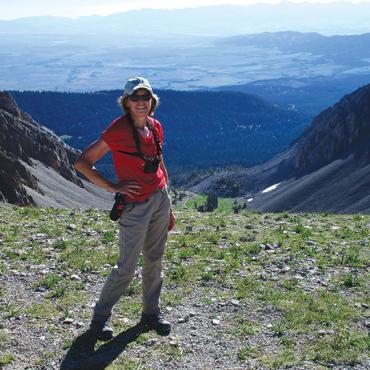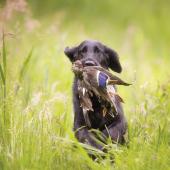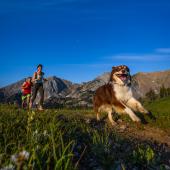Training Day
Introducing your puppy to the trail.
If you think about it, hiking with your dog can subject her to the same maneuvers as an agility course—jumping and weaving between obstacles, maybe even balancing on a log bridge.
Agility competition with my border collie taught me the importance of slow and steady training to avoid injury. That goes double for goofy, clumsy puppies. It’s hard to imagine busy, robust little Scout getting hurt, but it happens. The “growth plates” in puppies’ legs can take up to a year to fuse. Jumping something taller than the hock (that elbow-like back leg joint) or repetitive, rigorous exercise can cause injury, resulting in a potentially long recovery and early onset arthritis.
Puppies don’t know their limits and will play beyond their reserve. When walking Scout, the rule of thumb is five minutes per month of age, twice a day. My “Rez dog” is five months old, which means he can keep up on a walk for about 25 minutes every morning and afternoon. By the time we hit the muddy, early summer trails, he’ll be able to handle an easy 40-minute hike.
For the sake of Scout’s longevity and safety, start on flatter, shorter trails until she builds stamina and muscle. Depending on the breed, dogs are generally considered full-grown between one and two years old. At that point, if properly conditioned, Scout can accompany you into the backcountry. If you plan on taking her over rough terrain, you might consider a pair of booties to protect her pads from cuts.
One of my pet peeves (ha) when hiking is getting ambushed by a loose dog. My border collie, Gib, is often leashed when hiking due to his propensity to chase deer. Last summer we were both wiped out on a steep, scree-laden section of trail by an off-leash, exuberant Bernese mountain dog puppy. Her super-cuteness and lolling-tongued smile did little to mollify me as I unwound Gib’s leash from my ankle and picked rocks out of my palm. The dog’s owner ran by a few seconds later, glanced briefly at us, then pulled his ear buds out just long enough to yell, “Come on, Molly!”

Which brings up an oft-debated topic on Montana’s dog-friendly trails. The leash—use it or lose it?
Until Scout has a reliable recall, it’s safest to keep her leashed for a variety of reasons, not the least of which is other dogs.
Gib happens to be a very even-tempered (neutered) male who usually tolerates getting blindsided by other canines, especially if they’re of the female persuasion. Not all dogs are wired like Gib. Older dogs might not appreciate fast-moving whipper-snappers, and, worst case scenario, may take a chunk out of sweet, innocent Scout.
Then there are health risks. Contagious viruses like kennel cough are especially damaging to young dogs. Be sure Scout’s vaccinations are current before hitting the trail.
Hikers, bicyclists and horses often share the same trails in Montana. Teach Scout to yield to bikes and horses, and not chase after them. My horse is “dog proof” enough that he simply pinned his ears at the dog that grabbed and hung onto his tail on a trail in Colorado. Most horses will kick a dog in the head for that indiscretion. Not a lesson young Scout wants to learn.
Gib alerted me to the only prairie rattler I’ve seen on a Montana trail. If he hadn’t been leashed, he would have gotten tagged. Adult dogs usually survive a rattlesnake bite if taken to the vet right away, but a puppy’s chances are worse.
Symptoms of heat exhaustion, heat stroke, and dehydration are lethargy, difficulty keeping up, and excessive panting. Your puppy might need up to a quart of water on the trail, so offer it, and maybe snacks, at regular intervals to keep her feeling spunky.
Teaching Scout the rules of the road, so to speak, results in a reliable partner who’s earned her seat beside the fire. Maybe you’ll howl at the moon together, or teach her to catch a fish. The possibilities are endless. And Scout will love you for it.














